Scottish household survey 2018: annual report
Results from the 2018 edition of the continuous survey based on a sample of the general population in private residences in Scotland.
7 Internet
Main Findings
Home internet access has increased steadily over time, reaching an all-time high of 87 per cent of households in 2018.
Forty-six per cent of households with internet access had a subscription to a superfast broadband service. an increase from 30 per cent in 2017.[85]
Households with lower incomes and households in Scotland’s most deprived areas were less likely to have home internet access than higher income households and those in less deprived areas, but the gap has narrowed in recent years.
Around one in eight (13 per cent) adults do not use the internet at all.
Older adults were less likely to use the internet, but the divide in internet use between younger and older adults has narrowed over time.
The use of smartphones to access the internet increased again in 2018, and was more common than the use of a PC or laptop to access the internet.
The most common activities undertaken by those who had access to the internet included sending and receiving emails (90 per cent) and searching for information (87 per cent).
The most common reason that could convince people who don’t use the internet for personal use to go online was keeping in touch with family and friends at no extra cost (10 per cent).
Over one third (36 per cent) of internet users stated that security concerns made them less likely to share personal information online.
7.1 Introduction and Context
The Scottish Government is committed to ensuring that all of Scotland is well positioned to take full advantage of all opportunities offered by the digital age. This includes a vision of a Scotland where: businesses and individuals are making effective use of digital tools, public services are designed around the needs of users, high quality connectivity is provided across the whole of the country, the current gender gap in digital skills and careers is addressed and where digital technology is supporting inclusive economic growth, fair and rewarding work, social cohesion and future innovation.
Part of the Scottish Government’s Digital Strategy[86] is to increase digital participation in order to enable social mobility and tackle persistent inequalities. Digital participation refers to people’s ability to gain access to digital technology and use it effectively, creatively and with confidence. Being able to use the internet provides access to a range of political, educational, cultural and economic resources and is thereby an important facilitator of social inclusion. Ultimately, increased digital participation can improve people’s quality of life, boost economic growth and allow for a more effective delivery of public services.
The SHS provides information on a number of relevant areas of digital participation that can be used to measure progress. This chapter begins by looking at take-up of internet and broadband by households in Scotland, with a focus on how this varies by income and area. It then looks at personal use of internet – including where and how the internet is accessed – by key demographic factors, such as age, health status, income and deprivation. Next, there is coverage of some more specific use, in order to understand the activities for which the internet is being used and how confident users are at undertaking different activities.
The next section looks at the reasons why adults do not use the internet and the use of public services websites to access information and services.
The final part of the chapter looks at the online security measures taken by internet users, and explores how security concerns are affecting the way in which people use the internet.
7.2 Internet Access and Use
7.2.1 Internet Access
In 2018, the proportion of households with home internet access was stable compared to 2017 (87 per cent and 85 per cent, respectively) (Figure 7.1). The share has increased steadily from 42 per cent of households surveyed in 2003.
Figure 7.1: Households with home internet access by year
2003-2018 data, Households (minimum base: 2,870)
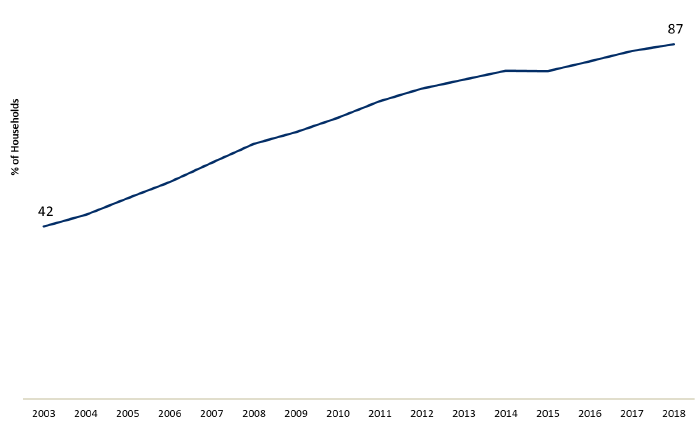
7.2.2 Variations in internet access
Home internet access tended to increase with household income (Figure 7.2). In 2018, 69 per cent of households with an income of less than £10,000 had internet access at home. In comparison, almost all (99 per cent) households with an income of 40,000 and over had home internet access.
Since 2003, the gap in home internet access between the lowest income group (£0 - £6,000) and the highest income group (over £40,000), has decreased from 69 percentage points to 30 percentage points in 2018 (Figure 7.3).
Figure 7.2: Households with home internet access by net annual household income
2018 data, households (minimum base: 70)
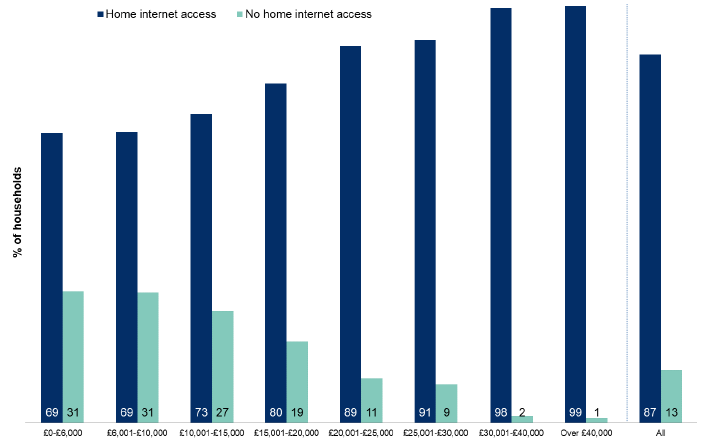
Figure 7.3: Households with home internet access by year and net annual household income
2003 - 2018 data, households (minimum base: 70)
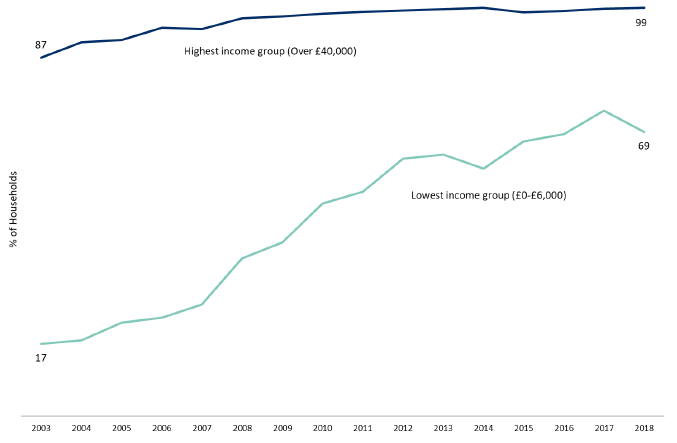
Households in the 20 per cent most deprived areas[87] in Scotland were less likely than those in the 20 per cent least deprived areas to have access to the internet at home (82 per cent and 94 per cent respectively in 2018; Figure 7.4).
The gap in home internet access between households in Scotland’s 20 per cent most and 20 per cent least deprived areas has decreased gradually over time from 36 percentage points in 2006 to 12 percentage points in 2018.
Figure 7.4: Households with home internet access by area deprivation[88]
2006 - 2018 data, households (minimum base: 540)
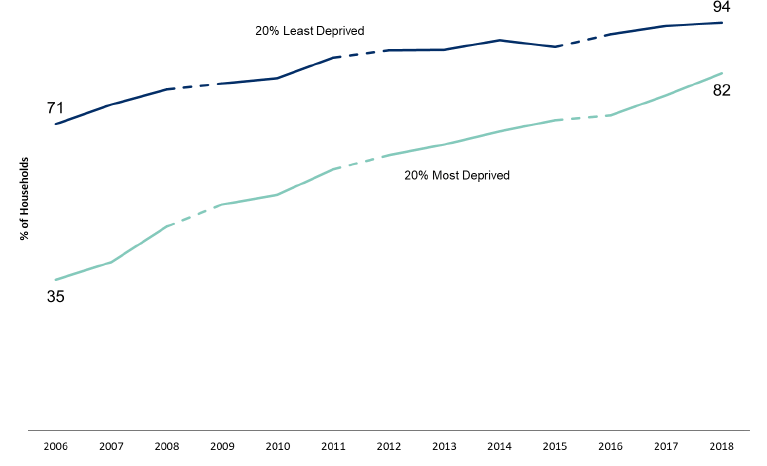
Figure 7.5 shows how home internet access varied by tenure. Ninety per cent of households who owned their home and 91 per cent of those in private rented housing had home internet access compared to 75 per cent of those in social rented housing.
Figure 7.5: Households with internet access at home by tenure
2018 data, Households (minimum base: 350)
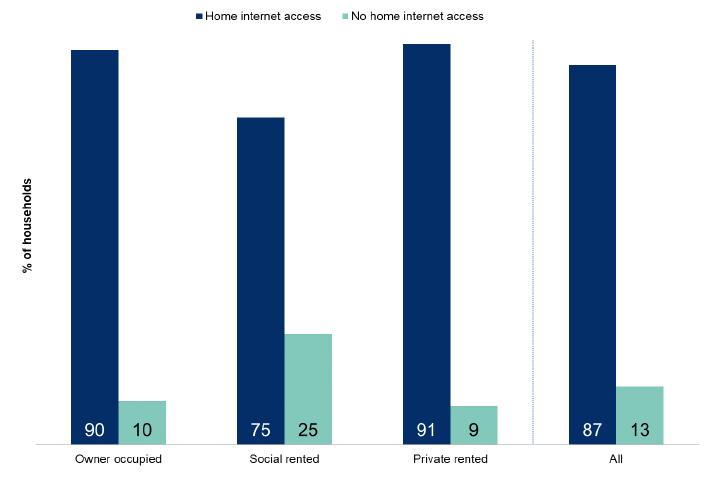
Figure 7.6 shows the prevalence of home internet access by area, based on Urban Rural Classification. There was no significant variation in access between households across different geographies.
Figure 7.6: Households with home internet access by Urban Rural Classification
2018 data, Households (minimum base: 160)
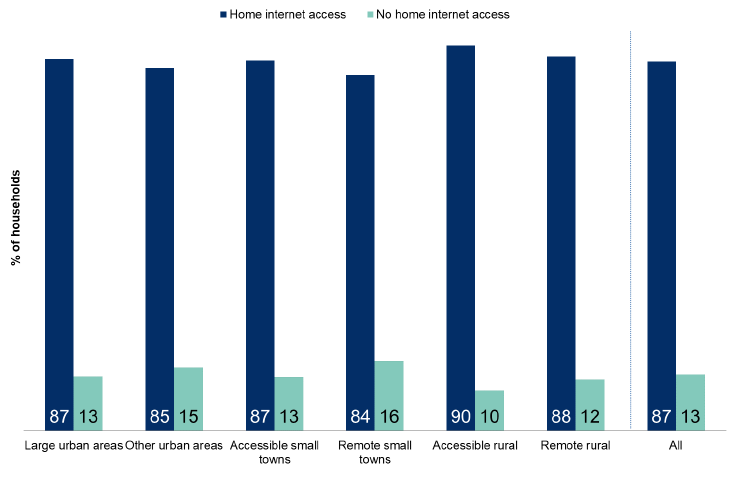
Since 2007, the SHS has asked households who reported having access to the internet at home about what type of connection they have. The vast majority of households with internet access at home had a broadband connection in 2018 (99 per cent), and 46 per cent had access via a superfast broadband subscription, an increase from 30 per cent in 2017[89].
7.2.3 Internet Use
In addition to the questions on household take-up of internet and broadband, the SHS asks a randomly selected adult in the household whether they use the internet either for work or personal use. Internet use has increased since 2007 from 65 per cent to 87 per cent in 2018 (Figure 7.7).
Figure 7.7 and Figure 7.8 show that there is a clear relationship between age and use of internet, with lower rates of internet use among older adults. In 2018, 100 per cent of adults aged 16 to 24 reported using the internet compared to 38 per cent of those aged 75 and over. Thirteen per cent of all adults stated that they did not use the internet at all.
Although older adults were less likely to use the internet, the gap in internet use between adults aged 16-24 and adults aged 60 and above has fallen over time from 57 percentage points in 2007 to 35 percentage points in 2018[90]. This result has mainly been driven by an increase in internet use amongst adults aged 60+ (from 29 per cent to 65 per cent).
Figure 7.7: Use of internet by year and age
2007 – 2018 data, Adults (minimum base: 300)
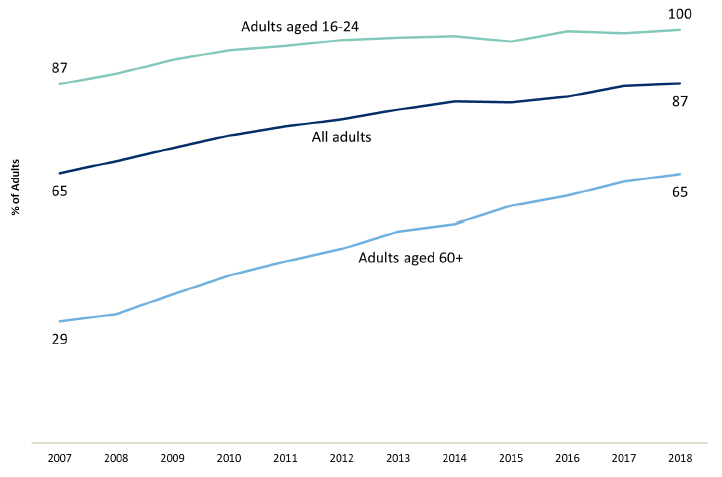
Figure 7.8: Use of the internet by age
2018 data, Adults (minimum base: 320)

The following section mainly focuses on those who do not use the internet at all. In order to increase digital participation and enable more people to enjoy the benefits that the internet can offer, it is important to identify if there are any groups of society that face barriers accessing or using the internet. In particular, this section looks at those who do not use the internet by health, income, level of deprivation and tenure.
Twenty-seven per cent of adults who have some form of long-standing physical or mental health condition or illness reported not using the internet, compared with eight per cent of those who do not have any such condition (Table 7.1). This divide in internet use is more marked among the older age groups, but is prevalent across all age bands to some extent with the exception of 16-24 year olds.
Table 7.1: Proportion of adults who do not use the internet by age and whether they have a physical or mental health condition lasting or expecting to last 12 months or more
Column percentages, 2018 data
| Does not have a physical or mental health condition or illness | Has a physical or mental health condition | All | |
|---|---|---|---|
| 16-24 | |||
| Internet user | 100 | 100 | 100 |
| Does not use the internet | - | - | - |
| Base | 270 | 50 | 320 |
| 25-34 | |||
| Internet user | 99 | 96 | 98 |
| Does not use the internet | 1 | 4 | 2 |
| Base | 470 | 120 | 590 |
| 35-44 | |||
| Internet user | 99 | 92 | 98 |
| Does not use the internet | 1 | 8 | 2 |
| Base | 490 | 140 | 630 |
| 45-59 | |||
| Internet user | 95 | 82 | 91 |
| Does not use the internet | 5 | 18 | 9 |
| Base | 740 | 350 | 1,090 |
| 60-74 | |||
| Internet user | 81 | 72 | 77 |
| Does not use the internet | 19 | 28 | 23 |
| Base | 620 | 480 | 1,100 |
| 75+ | |||
| Internet user | 49 | 31 | 39 |
| Does not use the internet | 51 | 69 | 61 |
| Base | 260 | 370 | 620 |
| All | |||
| Internet user | 92 | 73 | 87 |
| Does not use the internet | 8 | 27 | 13 |
| Base | 2,840 | 1,500 | 4,350 |
Excludes ‘Don’t know’/’Refused’ statements
Figure 7.9 shows that, as with internet access, internet use increased with income, with a break in the trend for the lowest income bracket. This may be due to a disproportionate percentage of those on a low income (£0-£6,000) being students (32 per cent) compared to other income brackets where students make up between four and seven per cent of the group of respondents.
Two per cent of adults living in a household with a total net income of £40,000 or more did not use the internet in 2018 compared with 31 per cent of those in the £6,001-£10,000 bracket. Since 2007, the gap in internet use between adults in the lowest income group (£0-£6,000) and the highest income group (over £40,000) has fallen from 54 to 17 percentage points (Figure 7.10).
Figure 7.9: Use of the internet by net annual household income
2018 data, Adults (minimum base: 110)

Figure 7.10: Use of the internet by year and net annual household income
2007 - 2018 data, Adults (minimum base: 110)

As with internet access, there was a difference in internet use by area deprivation (Figure 7.11). Nineteen per cent of adults living in the 20 per cent most deprived areas in Scotland reported not using the internet in 2018, compared to seven per cent in the 20 per cent least deprived areas.
Figure 7.11: Adults in the 20 per cent most and least deprived areas who do not use the internet
2018 data, Adults (minimum base: 800)
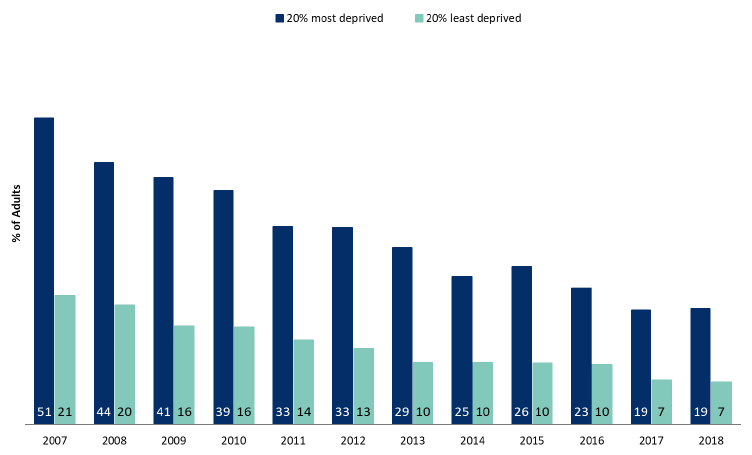
Twenty-three per cent of adults in social rented housing reported not using the internet in 2018, compared to only five per cent of those in private rented housing and 12 per cent of those that owned their own homes (Figure 7.12).
Figure 7.12: Use of the internet by tenure[91]
2018 data, Adults (minimum base: 530)
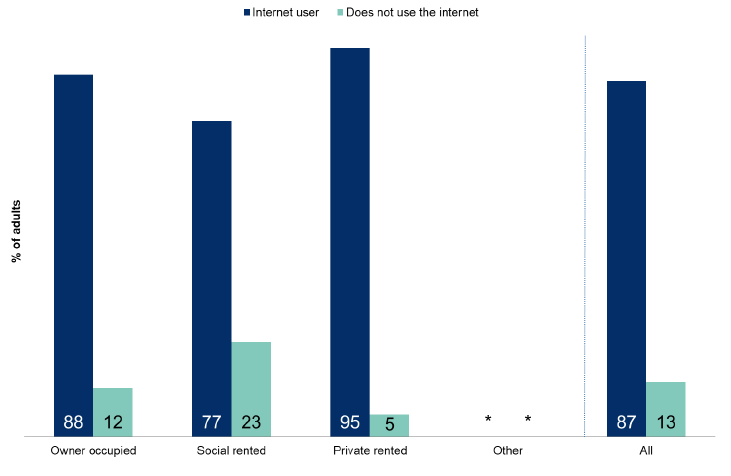
7.3 Where and How Users Access the Internet
The ways in which people access the internet are becoming increasingly diverse. Since 2007, the SHS has asked adults who use the internet for personal use about the locations where they access it and the methods they use.
7.3.1 Where internet users access the internet
Almost all internet users (97 per cent) said that they used the internet at home (Table 7.2). Those reporting that they accessed the internet on the move using a mobile phone or tablet has declined by four percentage points since 2017[92] to 54 per cent in 2018. Three in 10 internet users (30 per cent) said that they make personal use of the internet at work.
There is a broadly positive relationship between household income and the share of internet users accessing the internet on the move via a smartphone or tablet. A positive relationship is also displayed between income and the share of internet users making personal use of the internet at work.
Table 7.2: Where adults who use the internet access it for personal use by annual net income
Percentages, 2018 data
| Adults who make personal use of the internet | £0-£6,000 | £6,001-£10,000 | £10,001-£15,000 | £15,001-£20,000 | £20,001-£25,000 | £25,001-£30,000 | £30,001-£40,000 | Over £40,000 | All |
|---|---|---|---|---|---|---|---|---|---|
| At home | * | 93 | 93 | 97 | 98 | 97 | 99 | 99 | 97 |
| On the move via a mobile phone/smartphone/tablet | * | 38 | 47 | 50 | 50 | 50 | 58 | 61 | 54 |
| At work | * | 12 | 17 | 16 | 17 | 24 | 39 | 44 | 30 |
| At another person's home | * | 15 | 13 | 13 | 8 | 12 | 12 | 14 | 13 |
| School, college, university, other educational institution | * | 18 | 9 | 9 | 10 | 8 | 7 | 5 | 8 |
| Public library | * | 9 | 6 | 4 | 3 | 3 | 3 | 2 | 4 |
| Somewhere else | * | 2 | - | 3 | 1 | 1 | 2 | 1 | 1 |
| Community or voluntary centre/organisation | * | - | - | 1 | 1 | 2 | 1 | 0 | 1 |
| A government/council office | * | 2 | 0 | 1 | 0 | 0 | 0 | 1 | 1 |
| Base (minimum) | 50 | 130 | 250 | 300 | 250 | 220 | 340 | 560 | 2,090 |
There is a negative relationship between increased deprivation and the share of smart appliances in the home (Table 7.3). Households with internet access in the 20 per cent most deprived areas in Scotland were less likely to own smart appliances, with 83 per cent of those in the most deprived areas having no smart appliances compared to 66 per cent in the least deprived areas.
Table 7.3: Smart appliances in the house by area deprivation
Column percentages, 2018 data
| Adults | 20% Most Deprived | 20% Least Deprived | All |
|---|---|---|---|
| Smart heating (eg Nest or Hive thermostats) | 3 | 10 | 6 |
| Smart lighting (eg Philips Hue) | 1 | 3 | 2 |
| Smart home monitoring or security systems (Nest or Panasonic camera) | 1 | 3 | 2 |
| Smart speakers (eg Amazon Echo, Google Home) | 9 | 18 | 12 |
| Wearable Technology (eg Fitbit, Smart watch etc) | 10 | 23 | 17 |
| None of the above | 83 | 66 | 74 |
| Base (minimum) | 440 | 500 | 2,430 |
7.3.2 How internet users access the internet
Table 7.4 shows which methods were used to access the internet for personal use by age. Younger internet users were more likely to access the internet using a smartphone than older users, with 96 per cent of 16-24 year olds using smartphones compared to 29 per cent of adults aged 75 and above. This age divide can also be seen in the use of digital, cable or satellite television to access the internet and games consoles. Older internet users were more likely than younger users to use a tablet to access the internet.
The proportion of internet users reporting that they access the internet using a smartphone increased (from 78 per cent in 2017[93] to 81 per cent in 2018), and was greater than the share of internet users using a PC or laptop to go online (75 per cent). Sixty-one per cent of respondents reported using both a smartphone and a PC or laptop to access the internet.
Table 7.4: Methods used by adults who use the internet for personal use by age
Percentages, 2018 data
| Adults who make personal use of the internet | 16-24 | 25-34 | 35-44 | 45-59 | 60-74 | 75 plus | All |
|---|---|---|---|---|---|---|---|
| A personal computer or laptop | 74 | 74 | 75 | 79 | 74 | 72 | 75 |
| Mobile phone/iPhone/Smartphone | 96 | 93 | 91 | 80 | 61 | 29 | 81 |
| A tablet - iPad/Playbook or similar | 41 | 52 | 58 | 62 | 57 | 50 | 54 |
| Digital, cable or satellite television | 20 | 26 | 25 | 20 | 10 | 11 | 20 |
| A games console | 37 | 25 | 17 | 10 | 1 | 1 | 17 |
| Another way | 1 | - | - | 1 | - | - | 0 |
| Other than a personal computer or laptop | 98 | 95 | 94 | 88 | 81 | 61 | 90 |
| Base (minimum) | 210 | 370 | 370 | 570 | 500 | 140 | 2,150 |
Columns may not add up to 100 per cent as multiple responses were allowed
7.3.3 Common internet activities and online confidence
As shown in Table 7.5, the most common activities undertaken by those who had access to the internet included sending and receiving emails (90 per cent of all adults who made personal use of the internet), searching for information (87 per cent), buying goods or services (77 per cent), using social media (75 per cent) and internet banking (69 per cent). Adults renting private housing were the most likely to use the internet for making telephone/video calls, social media and looking/applying for jobs. Those in social rented housing were least likely to use the internet for banking, to send and receive e-mails or for buying goods or services.
Table 7.5: Reasons for using the internet by tenure
Percentages, 2018 data
| Adults who make personal use of the internet | Owner occupied | Social rented | Private rented | Other | All |
|---|---|---|---|---|---|
| Send and receive e-mails | 93 | 80 | 91 | * | 90 |
| Search for information | 90 | 77 | 84 | * | 87 |
| Buy goods or services | 79 | 68 | 79 | * | 77 |
| Use social media (such as facebook or twitter) | 72 | 77 | 84 | * | 75 |
| Internet banking | 70 | 59 | 74 | * | 69 |
| Play or download games, films or music | 52 | 56 | 58 | * | 54 |
| Make telephone/video calls over the internet | 53 | 44 | 62 | * | 53 |
| Look for/apply for jobs | 25 | 26 | 37 | * | 27 |
| Create websites or blogs | 10 | 6 | 15 | * | 10 |
| To learn something new | 49 | 38 | 51 | * | 47 |
| None of these | 1 | 3 | 1 | * | 1 |
| Base (minimum) | 1,430 | 400 | 290 | 30 | 2,150 |
Columns may not add up to 100 per cent as multiple responses were allowed
Among those that used the internet, a lower proportion of adults in social housing were confident in their ability to use the internet for any of the activities listed in Table 7.6 compared to those in private rented housing and those who owned their home. Adults in private rented housing were the most confident in their ability to use the internet for the listed activities.
Table 7.6: Confidence in pursuing activities when using the internet by tenure
Percentages, 2018 data
| Adults who make personal use of the internet | Owner occupied | Social rented | Private rented | Other | All |
|---|---|---|---|---|---|
| Send and receive e-mails | 93 | 85 | 96 | * | 92 |
| Use a search engine | 96 | 89 | 98 | * | 95 |
| Shop online | 91 | 81 | 94 | * | 89 |
| Use public services online | 88 | 76 | 90 | * | 86 |
| Identify and delete spam | 86 | 76 | 90 | * | 85 |
| Be able to tell what websites to trust | 85 | 76 | 90 | * | 84 |
| Control privacy settings online | 81 | 74 | 89 | * | 81 |
| Base (minimum) | 1,390 | 390 | 290 | 20 | 2,090 |
Columns may not add up to 100 per cent as multiple responses were allowed
7.4 People Who Do Not Use the Internet
As shown in Table 7.7, out of the options presented, the most common reasons that could convince people to go online were keeping in touch with family and friends at no extra cost (10 per cent), finding information about personal interests (six per cent) and accessing information about public services (five per cent).
The share of non-internet users stating that none of the reasons given would convince them to go online was 80 per cent in 2018.
Table 7.7: Reasons that could convince people, who don’t use the internet for personal use, to go online
Percentages, 2018 data
| Adults who make no personal use of the internet | |
|---|---|
| Accessing information about public services (e.g. bus timetables) | 5 |
| Keeping in touch with family and friends at no extra cost | 10 |
| Finding more jobs and applying quickly | 3 |
| Accessing online learning resources | 3 |
| Connecting with healthcare services (e.g. making appointments, ordering prescriptions) | 3 |
| Managing and saving money (e.g. via online shopping and banking) | 3 |
| Finding information about personal interests | 6 |
| None of the above | 80 |
| Base (minimum) | 580 |
Columns may not add up to 100 per cent as multiple responses were allowed
7.5 Use of Public Services Websites
It is possible to access an increasing number of public services and information online. Online services can be quicker and more convenient for people to use, and can be provided at a lower cost than other methods. However, a person’s use of websites to access public services is dependent upon both internet access and their tendency to access information or services online. The SHS explores people’s use of digitally delivered public services by asking which, if any, things they have used the websites for.
Table 7.8 presents the reasons why internet users reported having used a public services website over the past 12 months. The most common reason for using public services websites was looking for information (87 per cent).
Table 7.8: Use of public services on the internet in the past 12 months
Percentages, 2018 data
| Adults who make use of the internet | |
|---|---|
| Look for information | 87 |
| Download forms | 23 |
| Send completed forms | 22 |
| Ask a question | 21 |
| Make a complaint | 10 |
| Access services like report a fault, renew library books, planning applications | 14 |
| Make a payment (council tax etc.) | 23 |
| Apply for a job | 9 |
| Apply for funding (housing benefit, legal aid or student funding) | 7 |
| Report a crime | 3 |
| Participate in a consultation | 4 |
| Another reason | 9 |
| Base | 1,680 |
Columns may not add up to 100 per cent as multiple responses were allowed
As shown in Table 7.9, 86 per cent of adults were fairly or very satisfied with the overall quality of the public services they had used online. Only five per cent of adults were fairly or very dissatisfied.
Table 7.9: Satisfaction with quality of public service websites
Column percentages, 2018 data
| Adults who make use of the internet | |
|---|---|
| Very/fairly satisfied | 86 |
| Neither satisfied nor dissatisfied | 8 |
| Very/fairly dissatisfied | 5 |
| Don't know | - |
| Base | 1,680 |
7.6 Online Safety and Security
Since 2015, the SHS has asked about the security measures adults take to protect themselves whilst online and how security concerns are impacting on internet use.
7.6.1 Security measures used online
Table 7.10 shows that some online security measures were more popular than others. The most common online security measures taken were avoiding opening emails or attachments from unknown people (70 per cent), avoiding giving personal information online (69 per cent), making sure my home has up-to-date anti-virus software (63 per cent) and making sure my home wi-fi is protected with a username and password (63 per cent). The share of internet users who said they made sure their mobile phone had up-to-date anti-virus software increased from 40 per cent to 46 per cent since 2017[94].
Use of the various online security measures varied by age, with those aged 60 and above generally less likely to adopt each of the measures than those in younger age groups. In particular, internet users aged 75+ were notably less likely to use online security measures, with 23 per cent stating that they did not take any of the suggested actions. Whilst 72 per cent of internet users aged 16-24 said that they avoid giving personal information online, only 64 per cent of those aged 60-75 and 49 per cent of those aged 75 and above did the same.
Adults living in the 20 per cent most deprived areas of Scotland were less likely than those in the 20 per cent least deprived areas to adopt each of the security measures, and more likely to say that they took none of the suggested actions. For example, 58 per cent of those living in the 20 per cent most deprived areas stated that they avoid opening emails or attatchments from unknown people, compared to 77 per cent of those in the 20 per cent least deprived areas.
Table 7.10: Online security measures taken by age and deprivation
Percentages, 2018 data
| Adults who make use of the internet | 16-24 | 25-34 | 35-44 | 45-59 | 60-74 | 75 plus | 20% Most Deprived | 20% Least Deprived | All |
|---|---|---|---|---|---|---|---|---|---|
| Avoid opening emails or attachments from unknown people | 69 | 71 | 71 | 73 | 66 | 54 | 58 | 77 | 70 |
| Avoid giving personal information online | 72 | 73 | 72 | 69 | 64 | 49 | 64 | 74 | 69 |
| Use different passwords for different accounts | 57 | 66 | 65 | 63 | 58 | 48 | 53 | 66 | 61 |
| Make sure my home wi-fi is protected with a username and password | 57 | 70 | 68 | 66 | 59 | 37 | 53 | 71 | 63 |
| Make sure my computer has up-to-date anti-virus software | 67 | 61 | 63 | 63 | 63 | 53 | 52 | 72 | 63 |
| Download and install software updates/patches when prompted | 55 | 62 | 61 | 60 | 51 | 42 | 49 | 66 | 57 |
| Set passwords that include three random words | 32 | 38 | 34 | 37 | 29 | 21 | 33 | 35 | 34 |
| Back-up important information | 48 | 55 | 49 | 47 | 38 | 29 | 41 | 54 | 47 |
| Make sure my mobile phone has up-to-date anti-virus software | 50 | 52 | 49 | 48 | 40 | 19 | 40 | 53 | 46 |
| Change passwords for online accounts regularly | 33 | 40 | 41 | 34 | 28 | 21 | 34 | 39 | 35 |
| None of these | 10 | 7 | 7 | 9 | 12 | 23 | 16 | 5 | 9 |
| Base (minimum) | 210 | 370 | 370 | 570 | 500 | 140 | 390 | 440 | 2,150 |
Columns may not add up to 100 per cent as multiple responses were allowed
7.6.2 Impact of security concerns on internet use
Overall, the proportion of internet users who stated that security concerns had not caused them to change their internet use remained stable and was 45 per cent in 2018.
Table 7.11 shows that, in general, younger people were less likely to have changed their use of the internet as a result of security concerns. For example, only nine per cent of those aged 16-24 and six per cent of 35-34 year-olds said that security concerns made them less likely to bank online , compared to 20 per cent of those aged between 60-74, and 23 per cent of those aged 75 and above.
In some instances, the impact of security concerns on internet activity was greater for internet users with a long-term physical or mental health condition. For example, 17 per cent of internet users with a long-term condition reported that they were less likely to bank online due to security concerns, compared to 11 per cent of those without such a condition.
Table 7.11: Impact of security concerns on internet use by age and deprivation
Percentages, 2018 data
| Adults | Age | Long -term physical or mental health condition or illness | All | ||||||
|---|---|---|---|---|---|---|---|---|---|
| 16-24 | 25-34 | 35-44 | 45-59 | 60-74 | 75+ | Yes | No | ||
| Less likely to give personal information on websites | 31 | 32 | 34 | 39 | 42 | 33 | 39 | 35 | 36 |
| Only visit websites you know and trust | 27 | 30 | 35 | 34 | 37 | 34 | 35 | 32 | 33 |
| Only use your own computer/mobile device | 12 | 16 | 20 | 24 | 23 | 22 | 24 | 18 | 20 |
| Less likely to bank online | 9 | 6 | 9 | 14 | 20 | 23 | 17 | 11 | 12 |
| Less likely to buy goods online | 6 | 5 | 7 | 8 | 13 | 20 | 13 | 7 | 8 |
| Less likely to use the internet | 2 | 1 | 3 | 4 | 3 | 6 | 7 | 2 | 3 |
| No, none of the above | 56 | 50 | 45 | 41 | 38 | 45 | 42 | 47 | 45 |
| Base (minimum) | 210 | 370 | 370 | 570 | 500 | 140 | 610 | 1,540 | 2,150 |
Columns may not add up to 100 per cent as multiple responses were allowed
Contact
Email: shs@gov.scot
There is a problem
Thanks for your feedback